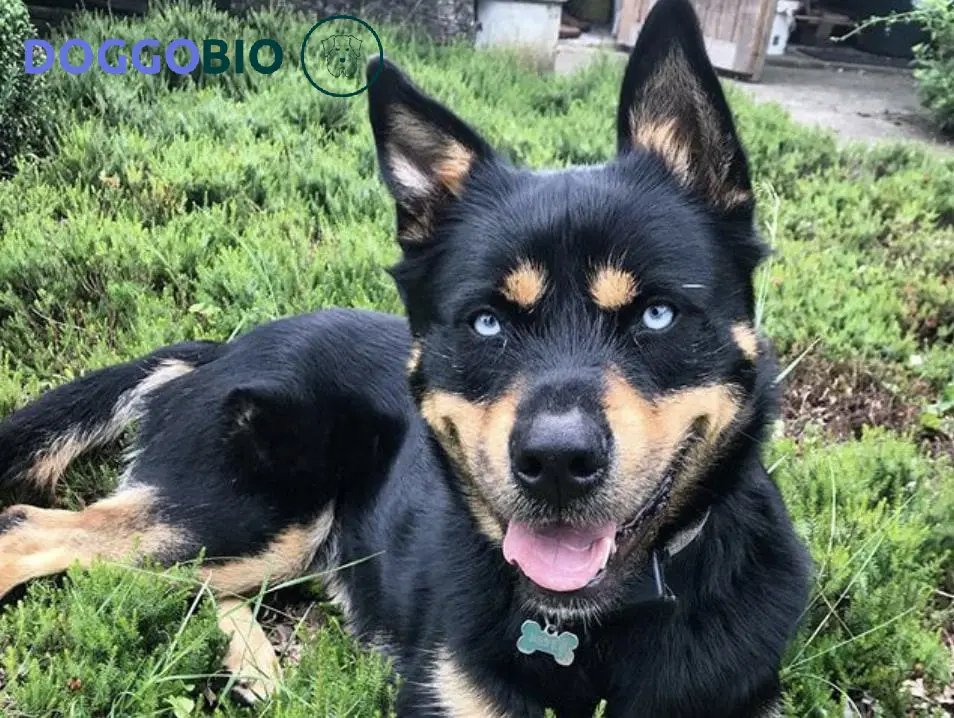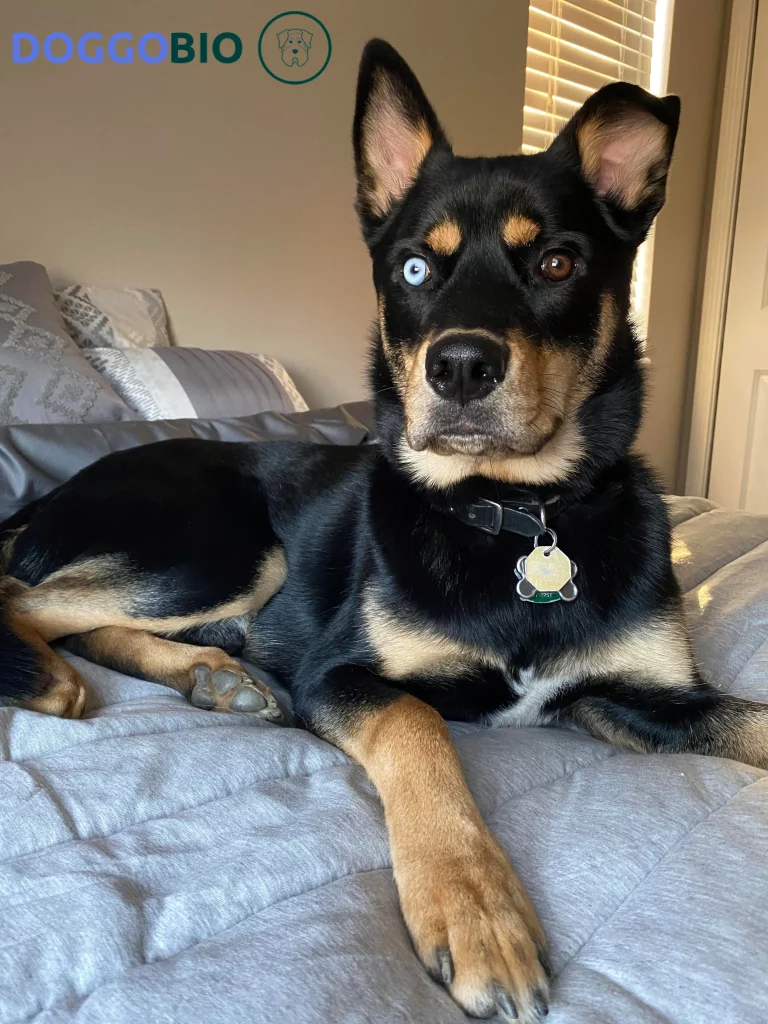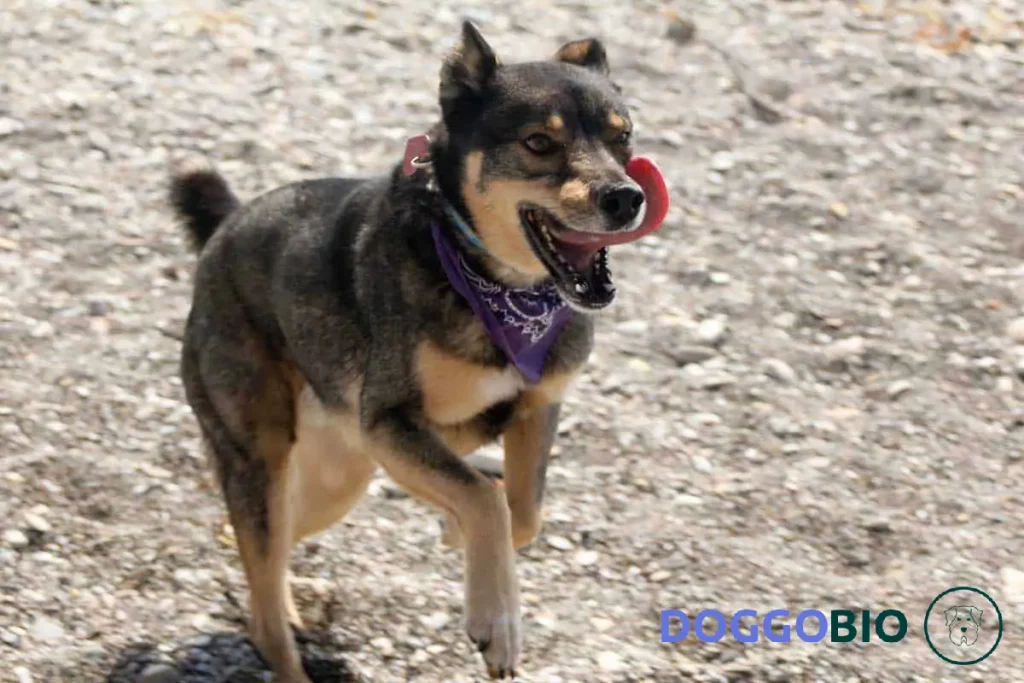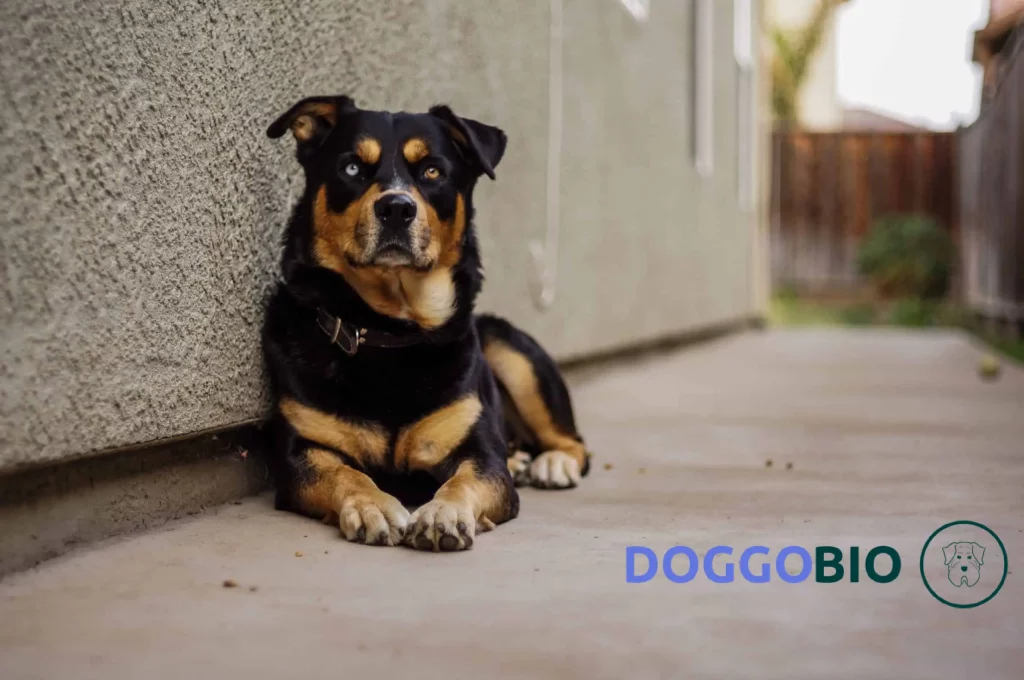The Rottweiler Husky mix, also known as a Rottsky, is a hybrid dog breed that crosses between a Rottweiler and a Siberian Husky. This unique combination of species makes a dog known for its strength, intelligence, and loyalty.
Rottskies can vary in appearance depending on their genetic makeup, but they often have a solid and muscular body with a thick, double coat that may be black, brown, or a mix of both.
They are highly energetic and require regular exercise and mental stimulation to thrive. Rottskies are also known for their protective instincts, making them excellent guard dogs and loyal companions to their owners.
A Brief Overview of Rottweiler Husky Mix
| Other Names | Rottsky, Husky Rottie Mix, Rott and Husky Mix |
| Purity | Hybrid |
| Purpose | Companion dog |
| AKC Recognition | No |
| Size | Large |
| Weight | 50 – 120 pounds |
| Height | 20 – 27 inches |
| Coat Colors | Black, Brown, Gray, Red, Sable, Cream, White |
| Exercise Needs | High |
| Lifespan | 9 – 13 years |
| Puppy Costs | $600 – $2,000 |
What is a Rottweiler Husky Mix?

The Rottweiler Husky mix, known as the Rottsky, is a blend of the robust Rottweiler and the energetic Siberian Husky. This crossbreed combines the distinctive traits of both parent breeds, resulting in a dog of impressive size and vigor. The Rottsky showcases the strength and endurance inherent in its lineage.
Parent Breeds of Rottweiler Husky Mix
To truly understand the intriguing and enigmatic Rottweiler Husky Mix, it’s essential to delve into the world of its two distinct parent breeds, examining the unique characteristics and traits that they each bring to the mix.
Origins and history of Rottweiler

The Rottweiler, a German breed with ancient Roman roots, is a powerful and intelligent canine known for its strength and endurance. Despite their intimidating reputation, Rottweilers are gentle giants, fiercely loyal to their families. They require early socialization and training to be well-behaved pets. When raised with care, they can be affectionate and playful. While they may be reserved with strangers, their unique blend of strength, intelligence, and loyalty has made them the eighth most popular dog breed in the United States.
Origins and history of Siberian Husky

The Siberian Husky, deeply rooted in Siberian history, served as the invaluable sled dogs for the Chukchi people. Their bond with humans was so strong that they even kept children and women warm at night.
These dignified and friendly dogs are pack animals, thriving on companionship. While they shed, their self-grooming nature minimizes odor. Despite this, they’re still the 14th most popular breed in the United States, known for their loyalty, intelligence, and grace.
What Does a Rottweiler Husky Mix Look Like?
The Rottweiler Husky mix, known as the Rottsky, has a unique appearance influenced by the dominant parent genes. They usually have Rottweiler-like body shapes but Husky-like faces with longer muzzles and partially drooping ears.
Their eyes are typically brown, but striking blue eyes from the Husky side are common. Some Rottskies even have heterochromatic eyes, with different or mixed colors. Their unpredictable appearance makes them fascinating and one-of-a-kind.

Size, height, and weight
It is important to note that each Rottsky will have unique features and measurements as there is no guarantee which traits they will inherit from each parent. They can grow up to 27 inches tall and weigh up to 120 pounds, or they can be as small as 21 inches and weigh just 35 pounds.
Coat colors and types
Their coat color is diverse, with options such as black, grey, brown, red, cream, white, and sable. The Rottsky’s nose is generally black, brown, or liver-colored.
While the Rottweiler and the Siberian Husky have double coats, they differ in texture. Rottweilers boast a short coat that lies flat against their body. In contrast, Siberian Huskies’ medium-length coats are designed to protect them from the harsh climate of northern Russia.
The type of coat a Rottweiler Husky mix will have depends on the individual dog, which adds to its unique appearance.
Temperament and Personality
Rottskies, a blend of two energetic working breeds, require ample exercise and mental stimulation. They can become destructive without it. They inherit independence from both Rottweilers and Huskies, needing consistent training and patience.
Due to their prey drive, they may not be suitable for homes with small pets or young children. However, they are incredibly loyal and loving companions. Early socialization is crucial for their well-rounded development.
Is Rottweiler Husky Mix a good fit for families?
Rottskies are high-energy dogs that require a lot of space to run and play. If you live in an apartment or are a couch potato, this is not the dog for you. They are also unsuitable for families with small children or pets due to their high prey drive.
In addition to their exercise needs, Rottskies shed a lot and are not hypoallergenic. Regular brushing is necessary to keep their fur and dander in check and also helps strengthen the bond between you and your dog.
However, with proper training and socialization from a young age, Rottskies can make excellent family companions. They are loyal, intelligent and protective of their families.
Is Rottweiler Husky Mix aggressive?
No, they are not inherently aggressive. The Rottweiler Husky Mix, while often perceived as aggressive due to the reputation of the Rottweiler, is not naturally aggressive. These hybrids are typically loyal and protective, and any aggressive behavior is usually a response to perceived threats. Their alertness and loyalty mean they will notify their owners of unfamiliar presences, but with proper training and socialization, they can be well-behaved and friendly dogs.
Training
Husky Rotts are intelligent, but their stubbornness and independence can challenge preparation. To give your Rottsky the best chance at success, start training early – ideally between 12 and 16 weeks old. Early training allows them to adapt to new environments and experiences.

There are a few tricks to keep your Rottweiler Husky Mix motivated during training.
- First, keep the sessions short and sweet to prevent boredom.
- Second, be consistent with your commands and rules – your furry friend wants to know what you expect of them.
- Finally, use positive reinforcement to encourage good behavior. This can be a simple praise or a firm “no” when they make a mistake.
With patience, persistence, and the proper training techniques, your Rottweiler Husky Mix can learn to be a well-behaved and happy member of your family.
Exercise Requirements
Exercise is a must for this active breed. Plan for 60 to 90 minutes of daily activity, which can include walks, runs, or games. Variety is key to keep them mentally and physically engaged.
Explore hikes, swimming, or agility classes. If time is tight, break exercise into two shorter sessions. Keep them moving and happy!
Grooming and Cleaning
Rottweiler Husky Mixes shed a lot due to their thick double coat. To manage the fur, brush them regularly and use a strong vacuum. Daily brushing during shedding seasons keeps their coat clean and shiny.
Bathing 2-3 times a month with gentle dog shampoo is sufficient, but ensure thorough drying to prevent mold growth. Additionally, keep their teeth clean and trim their nails regularly when you hear them tapping on the floor.
| Grooming Needs | Grooming Frequency |
| Bathing | Once a month. |
| Coat Brushing | 3 – 4 times per week. |
| Teeth Brushing | 3 – 4 times per week. |
| Nail Trimming | As needed. |
| Ear Cleaning | As needed. |
Is Rottweiler Husky Mix Hypoallergenic?
No, the Rottweiler Husky Mix is not considered hypoallergenic. Both parent breeds, the Rottweiler and the Husky, are moderate to high shedders. While some breeds may produce less dander or shed less, no dog is entirely hypoallergenic.
Rottskies require regular grooming to manage shedding, but they aren’t the best choice for those with allergies. If hypoallergenic traits are essential, it’s advisable to consider other breeds or mixes.
Food and Diet
Give them the right food and diet if you feed a Rottweiler Husky mix! These dogs are super active and require about 2 to 3.5 cups of dry kibble daily. And remember, their muscles need a high-protein diet to stay healthy and strong.
Common Health Issues
Regarding the health of Rottweiler Husky mixes, they are usually robust dogs. However, like any other breed, they are susceptible to genetic health problems, which we will discuss in detail.

1.Hip Dysplasia
Hip dysplasia is a genetic disorder that often affects large dog breeds like the Rottweiler Husky mix. This condition occurs when the thigh bone doesn’t fit properly into the hip joint. This can lead to arthritis and lameness over time if not treated properly
2.Bloat
Bloat is a severe condition of Rottweiler Husky mixes when their stomach fills with gas and twists on itself, causing shock. If you suspect your dog has bloat, seek veterinary care immediately.
To prevent bloat, it is recommended to give your dog small meals throughout the day rather than large meals and avoid strenuous exercise right after eating.
3.Osteosarcoma (bone cancer)
A tumor, which can be benign or malignant, is an abnormal growth of tissue that may cause harm to the body. In dogs, the most frequent bone tumor is osteosarcoma, which mainly develops in the leg bones of giant breeds. This type of cancer mostly affects middle-aged to older dogs and can be life-threatening.
4.Epilepsy
Epilepsy is a neurological condition that leads to sudden, uncontrolled seizures in dogs, including Rottweiler Husky mixes. However, the exact cause of this condition remains unknown. The symptoms of epilepsy in dogs can range from drooling to muscle twitching and can be quite distressing for both the dog and the owner.
5.Eyes problem
Cataracts, which occur when the eye lens becomes cloudy and can lead to blindness, are more prevalent in older dogs.
6.Heart Disease
Subaortic Stenosis is a complicated heart condition that is believed to be hereditary, causing constriction or narrowing of the aortic valve and can block blood flow.
How Long Does a Rottweiler Husky Mix Live?
A Rottweiler Husky Mix has a finite lifespan of approximately 9 to 13 years.
How Much Is a Rottweiler Husky Mix?
It’s difficult to determine the exact price of a Husky Rottweiler Mix. However, according to our research, the cost of this breed can range from $600 to $2,000.
This price is affected by various factors, such as the gender of the dog, the size of the litter, and the breeder’s reputation and location. Moreover, the color of the Rottweiler mixed with the Siberian Husky can also affect the price of the dog.
If you want to spend less money buying a dog, visit adoption and rescue centers. They offer a wide variety of dogs looking for a loving home. By adopting a dog, not only will you be saving a life, but you’ll also be getting a loyal companion for a fraction of the price.
Additionally, it would help if you remember that owning a dog comes with additional costs, such as dog food, vet trips, grooming, and pet insurance.
Is Rottweiler Husky Mix The Right Dog For You?

Want to know if a Rottweiler Husky Mix is the right dog breed for you? Well, it’s a yes if you’re up for spending an hour or more of your time daily for some rigorous exercise and activities with this energetic canine.
If you fail to provide the Rottweiler Husky Mix with good physical conditioning, don’t be surprised if your furry friend cheats everything in sight to release its pent-up energy.
However, the upside to this is that the large size of a Rottweiler mixed with a Husky can be intimidating enough to scare off potential intruders, making it an excellent family protector.
If you can commit to meeting the exercise and activity needs of a Rottweiler Husky Mix, you may have found yourself a loyal, loving, and protective companion.
List of dogs that are similar to Rottweiler Husky Mix
- Husky-Dalmatian Mix
- Husky-French Bulldog Mix
- Husky-Doberman Mix
- Husky-Cane Corso Mix
- Husky-Great Dane Mix
- Rottweiler-Blue Heeler Mix
- Rottweiler-Border Collie mix
- Rottweiler-Chihuahua Mix
- Rottweiler-Australian Shepherd Mix
Frequently Asked Questions
1.Do Rottweiler Husky Mixes Shed A Lot?
Yes, they do. The Rottie Husky Mix sheds moderately to heavily, especially during the fall and spring when they blow out their undercoat to prepare for the changing seasons. This means you can expect to find loose hair on furniture, carpets, and other areas of your home during these times. Regular grooming can help manage the shedding.
Conclusion
In conclusion, the Rottweiler Husky mix is a fascinating and unique hybrid breed that combines the traits of two distinct species. This breed is known for its physical strength, high energy levels, and intelligence, making it a popular choice for active and experienced dog owners.
While Rottskies can vary in appearance and temperament, they are typically loyal and protective companions who require regular exercise and mental stimulation to thrive.
With proper training and socialization, the Rottweiler Husky mix can make an excellent addition to any loving home prepared to provide them with the care and attention they need to thrive.

Pingback: Rottweiler Blue Heeler Mix: Dive into the Interesting World 2023
Pingback: Dalmatian Husky Mix: Interesting Facts You Need to Know 2023
Pingback: Miniature Husky: Dive Deep into the Interesting World 2023
Pingback: French Bulldog Husky Mix: Dive into the Interesting World 2023
Pingback: Great Dane Husky Mixes: Personality and Characteristics 2023
Pingback: Border Collie Rottweiler Mix: Energetic Charm Unleashed 2023
Pingback: Doberman Husky Mix: Fascinating Facts You Need to Know 2024
Pingback: Cane Corso Husky Mix: Interesting Fact You Need to Know 2024